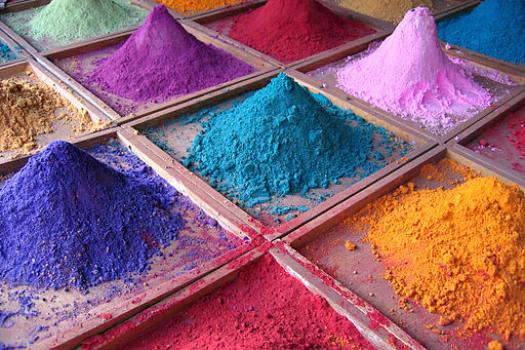How does light work? Absorption and reflection of colors
- Lesson Plan
- Video
- Feedback Form
Students play with colored transparencies to grasp which parts of the visible spectrum are absorbed and transmitted through objects. They use this knowledge to predict why they can see colors in our world.
MS.PS4.2
Develop and use a model to describe that waves are reflected, absorbed, or transmitted through various materials.
Materials
A flashlight for each student group
Red, orange, yellow, green, blue and purple color transparencies cut into small squares (about 2 x 2 inches), have one set of each color available for each student group
Lab sheet for each student
Optional– a prism for demonstration
Do Ahead
Prepare materials
This activity will work best if you can darken your classroom ahead of time
For a fun extension also have red and green gummy bears and a red-colored flashlight/ laser, see extension section.
Introduction
Remind your students about the EM spectrum and the visible light spectrum. Remind students that light needs to come from a source. Light comes from natural sources (our sun, stars, lava, fireflies, fire...) and from human-made sources (lightbulbs, electricity, etc.). Light travels as a wave and is reflected, transmitted and absorbed.
You can start this activity with a recap of light’s properties through a prism demonstration. Break apart white light into the rainbow of visible light. Remind students that all the colors of the rainbow are in white light.
Ask your students to look around. Let them know that the colors they see are due to the properties of the objects within the light's path.
Most plants are green. Is this because leaves absorb green? It is, of course, just the opposite, which is what students will learn in this activity.
Activity Directions
• Divide your students into groups of 2 or 3.
• Each student should have a lab sheet, a flashlight and a set of transparencies.
• Turn off lights and ask students to take turns shinning the flashlight through each transparency and observing what color they see.
• Ask students to discuss as a group why they see the color they do.
• When groups have tested each transparency turn on lights and discuss their answers.
• Direct students to the correct answer - for each color transparency the colors not seen transmitted, are absorbed. For example, for a green transparency, red, orange, yellow, blue and purple are absorbed. Only green passes through.
• Discuss with students how in this activity the light can pass through a transparency. What happens if the light is reflected instead of absorbed or transmitted? Answer - the reflected light is the color we see.
• Turn lights on and have students fill out the first page of their Lab Sheet.
• Now ask students what color will they see if they place all the transparencies together? Have them predict this on their Lab sheet.
• Turn off the lights and have students test their prediction. They should see no light transmitted because it is all absorbed.
• Turn on lights and have students fill our the remainder of their Lab Sheet.
Extension
• Give each student group 3-4 green and 3-4 red gummy bears and a red flashlight or red laser. Ask them to line up their gummy bears in a row. Ask students to predict what will happen when they direct the red flashlight through each set of colored gummy bears?
• Turn off the lights and have the students test their prediction. They should see the red light passes through the red gummy bears but not the green. This is because the green gummy bears absorb the red light. Did they make the right prediction? Hopefully yes…. Now time to eat a gummy bear!
| Attachment | Size |
|---|---|
| 296.11 KB | |
| 23.66 KB |
The activity is demonstrated in this video. Do not show this video to your students, use it as a reference for learning how to do the activity in your classroom.

